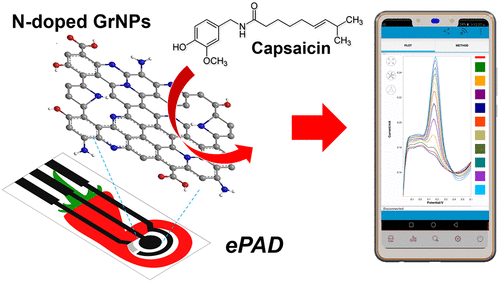当前位置:
X-MOL 学术
›
ACS Appl. Nano Mater.
›
论文详情
Our official English website, www.x-mol.net, welcomes your
feedback! (Note: you will need to create a separate account there.)
N-Doped Graphene Nanoplatelets for Direct Capsaicin Detection in Chili Pepper Samples
ACS Applied Nano Materials ( IF 5.3 ) Pub Date : 2020-09-09 , DOI: 10.1021/acsanm.0c02079 Asamee Soleh 1, 2, 3 , Kasrin Saisahas 4 , Kiattisak Promsuwan 1, 2, 3 , Panote Thavarungkul 1, 2, 5 , Proespichaya Kanatharana 1, 2, 3 , Warakorn Limbut 1, 2, 6
ACS Applied Nano Materials ( IF 5.3 ) Pub Date : 2020-09-09 , DOI: 10.1021/acsanm.0c02079 Asamee Soleh 1, 2, 3 , Kasrin Saisahas 4 , Kiattisak Promsuwan 1, 2, 3 , Panote Thavarungkul 1, 2, 5 , Proespichaya Kanatharana 1, 2, 3 , Warakorn Limbut 1, 2, 6
Affiliation

|
In this study, we have designed and fabricated a portable electrochemical sensor for direct detection of capsaicin in chili samples at the point-of-testing. The sensor, shaped like a chili pepper and highly portable, is essentially a disposable electrochemical paper-based analytical device (ePAD) modified with N-doped graphene nanoplatelets (GrNPs). The sensor consists of three components: (i) a small potentiostat device, (ii) an interface allowing connection to a smartphone for monitoring and control, and (iii) the sensor (an N-doped GrNPs/ePAD and detection chamber). The N-doped GrNPs/ePAD shows high conductivity and good electrocatalytic activity in the oxidation and reduction of capsaicin. The measurement of capsaicin was performed directly through differential pulse voltammetry once the parameters influencing capsaicin detection (i.e., pH, buffer ethanol content, N-doped GrNPs loading, accumulation potential, and accumulation time) were optimized. Linearity was obtained in the concentration range 1–100 μM, and the limit of detection was found to be 0.37 μM. Furthermore, the preparation of ten N-doped GrNPs/ePAD devices confirmed fabrication reproducibility. The sensor was successfully applied to the determination of capsaicin in chili samples, with recoveries between 89.3 ± 0.3 and 106 ± 2%, and the results showed no significant difference to those obtained by UV–vis spectrophotometry. Thus, this platform shows excellent potential for the development of portable sensors for capsaicin and future extension to different analytes.
中文翻译:

N掺杂石墨烯纳米血小板可直接检测辣椒样品中的辣椒素
在这项研究中,我们设计并制造了一种便携式电化学传感器,用于在测试点直接检测辣椒样品中的辣椒素。该传感器的形状像辣椒,具有高度的便携性,本质上是一种用N掺杂的石墨烯纳米片(GrNPs)改性的一次性电化学纸基分析设备(ePAD)。该传感器由三部分组成:(i)小型稳压器;(ii)允许连接至智能手机以进行监视和控制的接口;(iii)传感器(N掺杂的GrNPs / ePAD和检测室)。N掺杂的GrNPs / ePAD在辣椒素的氧化和还原中显示出高电导率和良好的电催化活性。一旦影响辣椒素检测的参数(例如,pH,优化了缓冲液乙醇含量,N掺杂GrNPs的装载量,积累潜力和积累时间)。线性范围为1-100μM,检出限为0.37μM。此外,制备十个氮掺杂的GrNPs / ePAD器件证实了制造的可重复性。该传感器已成功应用于辣椒样品中辣椒素的测定,回收率在89.3±0.3至106±2%之间,结果表明与紫外可见分光光度法所获得的结果无显着差异。因此,该平台在开发用于辣椒素的便携式传感器以及将来扩展到不同分析物方面显示出巨大的潜力。线性范围为1-100μM,检出限为0.37μM。此外,制备十个氮掺杂的GrNPs / ePAD器件证实了制造的可重复性。该传感器已成功应用于辣椒样品中辣椒素的测定,回收率在89.3±0.3至106±2%之间,结果表明与紫外可见分光光度法所获得的结果无显着差异。因此,该平台在开发用于辣椒素的便携式传感器以及将来扩展到不同分析物方面显示出巨大的潜力。线性范围为1-100μM,检出限为0.37μM。此外,制备十个氮掺杂的GrNPs / ePAD器件证实了制造的可重复性。该传感器已成功应用于辣椒样品中辣椒素的测定,回收率在89.3±0.3至106±2%之间,结果表明与紫外可见分光光度法所获得的结果无显着差异。因此,该平台在开发用于辣椒素的便携式传感器以及将来扩展到不同分析物方面显示出巨大的潜力。回收率在89.3±0.3和106±2%之间,结果显示与UV-vis分光光度法所得结果无显着差异。因此,该平台在开发用于辣椒素的便携式传感器以及将来扩展到不同分析物方面显示出巨大的潜力。回收率在89.3±0.3和106±2%之间,结果显示与UV-vis分光光度法所得结果无显着差异。因此,该平台在开发用于辣椒素的便携式传感器以及将来扩展到不同分析物方面显示出巨大的潜力。
更新日期:2020-10-25
中文翻译:

N掺杂石墨烯纳米血小板可直接检测辣椒样品中的辣椒素
在这项研究中,我们设计并制造了一种便携式电化学传感器,用于在测试点直接检测辣椒样品中的辣椒素。该传感器的形状像辣椒,具有高度的便携性,本质上是一种用N掺杂的石墨烯纳米片(GrNPs)改性的一次性电化学纸基分析设备(ePAD)。该传感器由三部分组成:(i)小型稳压器;(ii)允许连接至智能手机以进行监视和控制的接口;(iii)传感器(N掺杂的GrNPs / ePAD和检测室)。N掺杂的GrNPs / ePAD在辣椒素的氧化和还原中显示出高电导率和良好的电催化活性。一旦影响辣椒素检测的参数(例如,pH,优化了缓冲液乙醇含量,N掺杂GrNPs的装载量,积累潜力和积累时间)。线性范围为1-100μM,检出限为0.37μM。此外,制备十个氮掺杂的GrNPs / ePAD器件证实了制造的可重复性。该传感器已成功应用于辣椒样品中辣椒素的测定,回收率在89.3±0.3至106±2%之间,结果表明与紫外可见分光光度法所获得的结果无显着差异。因此,该平台在开发用于辣椒素的便携式传感器以及将来扩展到不同分析物方面显示出巨大的潜力。线性范围为1-100μM,检出限为0.37μM。此外,制备十个氮掺杂的GrNPs / ePAD器件证实了制造的可重复性。该传感器已成功应用于辣椒样品中辣椒素的测定,回收率在89.3±0.3至106±2%之间,结果表明与紫外可见分光光度法所获得的结果无显着差异。因此,该平台在开发用于辣椒素的便携式传感器以及将来扩展到不同分析物方面显示出巨大的潜力。线性范围为1-100μM,检出限为0.37μM。此外,制备十个氮掺杂的GrNPs / ePAD器件证实了制造的可重复性。该传感器已成功应用于辣椒样品中辣椒素的测定,回收率在89.3±0.3至106±2%之间,结果表明与紫外可见分光光度法所获得的结果无显着差异。因此,该平台在开发用于辣椒素的便携式传感器以及将来扩展到不同分析物方面显示出巨大的潜力。回收率在89.3±0.3和106±2%之间,结果显示与UV-vis分光光度法所得结果无显着差异。因此,该平台在开发用于辣椒素的便携式传感器以及将来扩展到不同分析物方面显示出巨大的潜力。回收率在89.3±0.3和106±2%之间,结果显示与UV-vis分光光度法所得结果无显着差异。因此,该平台在开发用于辣椒素的便携式传感器以及将来扩展到不同分析物方面显示出巨大的潜力。











































 京公网安备 11010802027423号
京公网安备 11010802027423号